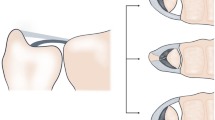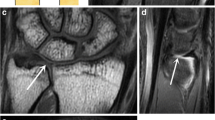Abstract
Objective: To evaluate the dynamic morphologic changes of the triangular fibrocartilage complex (TFCC) during pronation and supination of the forearm using high-resolution MR arthrography in cadavers and to evaluate the impact of these changes on the diagnostic assessment of the normal and abnormal TFCC. Design and specimens: High-resolution MR arthrography of 10 wrists of cadaveric specimens was obtained in maximum pronation, in the neutral position, and in maximum supination of the forearm. The structures of the TFCC were evaluated by two musculoskeletal radiologists and correlated with anatomic sections. The position of the forearm that allowed the best visualization of normal structures and lesions of the TFCC was determined. Results: The shape and extent of the articular disc as well as the radial portions of the radioulnar ligaments did not change with pronation and supination. The articular disc was horizontal in the neutral position and tilted more distally to align with the proximal carpal row in pronation and supination. The fibers of the ulnar part of the radioulnar ligaments (ulnar attachment of the articular disc) revealed the most significant changes: their orientation was coronal in the neutral position and sagittal in positions of pronation and supination. The ulnomeniscal homologue was largest in the neutral position and was reduced in size during pronation and supination. The extensor carpi ulnaris tendon was centered in its groove in the neutral position and pronation. In supination this tendon revealed subluxation from this groove. The dorsal capsule of the distal radioulnar joint was taut in pronation, and the palmar capsule was taut in supination. The preferred forearm position for analysis of most of the structures of the TFCC was the neutral position, followed by the pronated position. The neutral position was rated best for the detection of ulnar and radial detachments of the TFCC, followed by the pronated position, except for two central perforations of the TFCC which were best seen with supination. Conclusion: The articular disc and the surrounding radial portions of the radioulnar ligaments form a rigid, unified complex with the radius without change in their shape in positions of pronation and supination of the forearm, while the ulnar attachment of the TFCC shows important dynamic changes. The neutral forearm position is the best position to analyze both the normal and the abnormal TFCC.
Similar content being viewed by others
Author information
Authors and Affiliations
Additional information
Revision accepted: 1 August 2001
Electronic Publication
Rights and permissions
About this article
Cite this article
Pfirrmann, C.W., Theumann, N.H., Chung, C.B. et al. What happens to the triangular fibrocartilage complex during pronation and supination of the forearm? Analysis of its morphology and diagnostic assessment with MR arthrography. Skeletal Radiol 30, 677–685 (2001). https://doi.org/10.1007/s002560100429
Received:
Published:
Issue Date:
DOI: https://doi.org/10.1007/s002560100429




